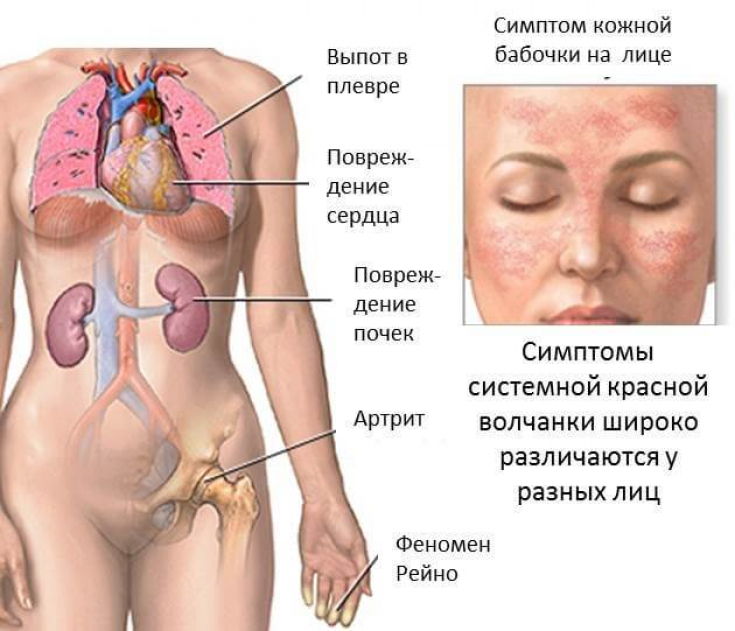Complete remission − lack of clinical activity without the use of glucocorticoids and immunosuppressive therapy, observed in systemic lupus erythematosusrarely.
Accordingly, treatment for SLE should aim to achieve remission or, failing this, to avoid all organ manifestations.
An article on estet-portal.com presents recommendations from the European League Against Rheumatism - EULAR) for the treatment of patients with specific manifestations of systemic lupus erythematosus.
- Goals of therapy for systemic lupus erythematosus in kidney disease
- Renal manifestations of systemic lupus erythematosus
- European guidelines for the treatment of kidneys in systemic lupus erythematosuske
Goals of therapy for systemic lupus erythematosus in kidney disease
For lupus nephritis (lupus nephritis), therapy should aim to achieve:
- partial remission (defined as ≥50% reduction in proteinuria from baseline to subnephrotic level, decrease in serum creatinine within 10% of baseline) within 6-12 months;
- complete remission (proteinuria
Follow us on Instagram!
During monitoring of renal response (response) reduction in proteinuria (to <0.8 g/day) after treatment of systemic lupus erythematosus is more important than residual hematuria.
Patients with more severe proteinuria and a longer duration of illness are less responsive to treatment or show more delayed responsesii.
Treatment of chronic cystitis: main directions and types of therapy
Renal manifestations of systemic lupus erythematosus
Patients with high risk of developing kidney disease (male, juvenile systemic lupus erythematosus, serologically active variants, including complement C1q antibodies) should be monitored closely (at least every 3 months) for detection of early signs of damage.
Once diagnosed by kidney biopsy, treatment of patients with lupus nephritis includes an initial induction phase followed by a long maintenance phase.

and cyclophosphamide − these are the immunosuppressive drugs of choice for induction treatment. Low dose cyclophosphamide is better than high dose because it is just as effective and has a
lower risk of gonadotoxicity. Published data support the use of high-dose mycophenolate mofetil and cyclophosphamide for severe forms of lupus nephritis associated with an increased risk of progression to
end-stage chronic renal failure:
decrease in glomerular filtration rate;- histologically determined the presence of fibrous «crescents» or fibrinoid necrosis, or tubular atrophy/interstitial fibrosis.
Modern features and possibilities of clinical urinalysis An early significant reduction in proteinuria (to ≤1 g/day for 6 months or ≤0.8 g/day for 12 months) is a favorable prognosis.
Mycophenolate mofetiland azathioprine can be used as maintenance therapy, with the former being associated with fewer relapses. The choice depends on the drug used for the induction phase and on the characteristics of the patient, including age, race and desire to become pregnant
eat. For refractory or recurrent disease, immunotherapy may be considered for − rituximab.
European guidelines for the treatment of kidneys in systemic lupus erythematosus
According to the EULAR (2012) guidelines for lupus nephritis, several studies have been published on the use of
calcineurin inhibitorsfor the treatment of proliferative lupus nephritis as monotherapy or in combination with (tacrolimus with mycophenolate mofetil) . These studies were conducted almost exclusively in Asian populations and had a short follow-up period.
For a multi-ethnic population, data must be confirmed by long-term studies.

can now be considered as second-line drugsfor induction or maintenance therapy, mainly for: membranous lupus nephritis;
- damage to podocytes;
- proliferative disease with refractory nephrotic syndrome despite standard treatment for 3-6 months
In the latter case, calcineurin inhibitors can be used alone or in combination with mycophenolate mofetil, as small studies have shown this combination to be effective in disease resistant to standard therapy.
calcineurin inhibitors
blood levels is essential to avoid chronic drug toxicity in the treatment of systemic lupus erythematosus.







Add a comment